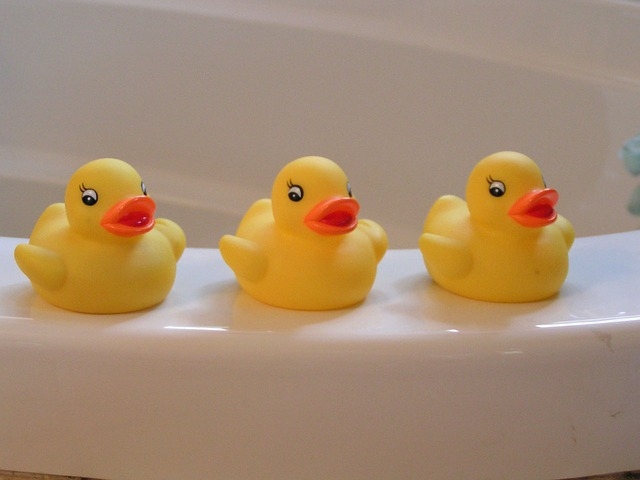
While working on this story, I discovered these ducks are on the U.S. Public Interest Research Group's list of 24 potentially hazardous toys. Why? Laboratory tests revealed high levels of a dangerous toxic chemical in the ducks.
The Trouble in Toyland 2014 report released this month warns shoppers that there are dangerous and toxic toys on store shelves this holiday season. The study found toys that you may want to avoid, that…
- are made of materials containing toxic chemicals such as lead
- have small parts that could choke a child if swallowed
- contain powerful magnets that if swallowed could cause intestinal injuries
- make noises loud enough to damage hearing.
So, how can you choose toys that are safe for your child (or nieces, etc.)? One way is to pick age-appropriate toys.
Many manufacturers label toys for age appropriateness. The guidelines factor in a child's developmental stage and the safety issues relevant for the child's age. That means that if you buy a toy labeled as appropriate for ages 4-5, for your “very advanced” 2 ½ year old daughter, you may be exposing her to safety risks.
In deciding what to buy, consider these guidelines from a fellow Cooperative Extension human development expert at Cornell University:
Children under 3: The biggest threat is toys with small parts that could choke them. Avoid marbles, magnets, and games with balls that are less than 1 3/4 inches in diameter. For example, when buying toys such as stuffed animals check to be sure eyes, noses, and other parts are attached securely. Otherwise a part might come lose and be dangerous if swallowed. (Follow this guideline for an older child who still mouths his toys.)
Children 3 to 5: Toys with straps or cords that fit around the neck, such as a toy guitar, is risky because a child could get the cord wrapped around her throat and be strangled. Avoid such toys until the child is older. Or to be safe, cut off cords, strings or straps until the he is older. Avoid toys that are made of thin plastic that can break into pieces or become jagged. Take the batteries out of loud toys or cover speakers with tape.
Children 6 to 12: Avoid toys with sharp or pointed edges, as well any that might easily break into pieces with sharp edges. The Consumer Product Safety Commission (CPSC) recommends NOT buying electric toys with heating elements for children under 8 years old. It advises anyone buying bikes, scooters, skateboards or inline skates to also buy protective gear such as a helmet, kneepads, elbow pads, and wrist guards.
Children and Teens:
- Magnets: Although the risk scenarios differ by age group, the danger is the same. When two or more magnets are swallowed, they can attract one another internally, resulting in serious injuries, such as small holes in the stomach and intestines, intestinal blockage, blood poisoning and even death. When a magnet has to be removed surgically, it often requires the repair of the child's damaged stomach and intestines.
- Toy Guns: Whether or not to buy toy guns is an individual matter. The University of Michigan Health System and recent events suggest toy guns should not look like real guns, and they should be brightly colored in order to be instantly recognizable as toys.
For more information, see Tips for Buying Safe Toys.
Patti Wooten Swanson, Ph.D., is a University of California Cooperative Extension nutrition, family and consumer science advisor in San Diego County.